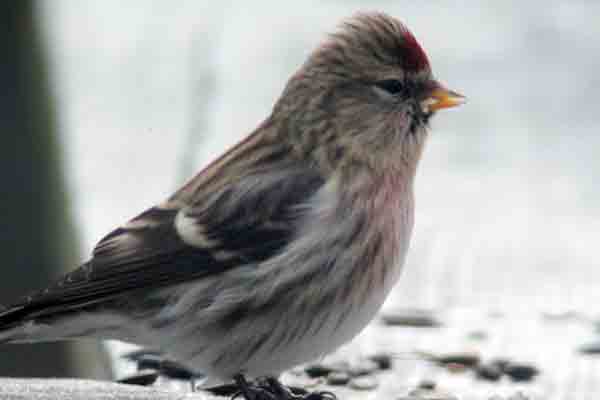Here is a wonderful article by Sue McGrath of the Newburyport (MA) Birders:
When I see Common Redpolls, I immediately think of the low-Arctic tundra, the land with short, dwarf-like shrubs that includes willow, alder, birch all of which support the Common Redpoll. These abundant, boreal and taiga region breeders share this habitat with foraging Willow Ptarmigan and patrolling Parasitic Jaegers.
Common Redpolls feed often upside down, hanging on small branches, using their feet to hold food items. As winter visitors to our area, they’re interested in our thistle feeders too. They are social birds that are associated with catkin-bearing trees in brushy and weedy areas. Redpolls are rotund and fluffy, sporting a tiny, yellow bill. Their characteristic features include dark lores, a black throat and chin and a red forecrown. The dark brown of the wings and tail along with the brown streaking of the nape, back, breast and flanks are offset by the whitish belly.

Characteristic features of Redpolls include dark lores, a black throat and chin and a red forecrown.
Redpolls have been observed on twigs, feeding each other by passing seed from conical bill to conical bill. The sexes are discernible ~ the male has pink on the chest and is less streaked; the female lacks that rosy hue and is heavily streaked. Their tails are forked, and in flight, the wingspan is 7 – 9 inches. They weigh 0.46 of an ounce.
Pete Dunne refers to this bird as “…effervescent pipsqueak of a finch with a small red beret and a black goatee.” What a clever way to remember their field marks!
Recently, I reread Kathleen S. Anderson’s article on Cumberland Farms in a 1996 issue of “Bird Observer” that has Barry W. Van Dusen’s illustration of Common Redpolls on the cover. In that issue, I found in W. E. Davis Jr.’s account of Common Redpolls that their have a specialized “pocket” in the neck area known as an esophageal diverticulum. A diverticulum is a sac or pouch arising from a tubular organ; crossbills also have this storage ability. This is like having an in-flight cupboard for storing seeds. This seed stockroom and the specialized winter-feeding behavior enable this songbird to survive colder temperatures. “The Birder’s Handbook” by Ehrlich, Dobkin and Wheye [page 641] refers to this partially bi-lobed pocket as analogous to the crop of gallinaceous birds.
Thermal regulation is also key to their survival. When in a sheltered area, redpolls fluff up their feathers to maximize heat retention. Frank Gill’s “Ornithology” states that Common Redpolls sleep in snow tunnels during the long Arctic night to conserve body heat. These winter visitors will feel more at home in New England when we’ve snow cover; they can insulate themselves against the cold, air temperatures.
Sue McGrath leads bird walks with the Essex County area — contact her if you are looking for a small group experience led by a good teacher/birder.
Discover more from Vermont Birder
Subscribe to get the latest posts sent to your email.

Pingback: Does Your Bird seed Get Eaten or Stored?
Pingback: Redpolls — Where Have You Been?